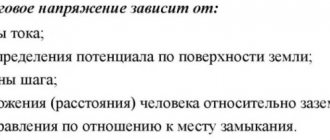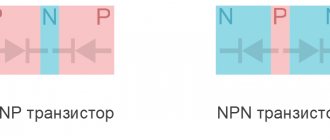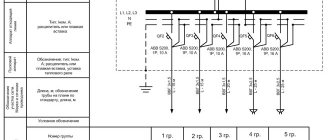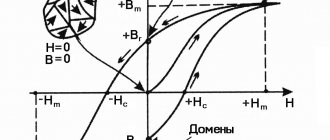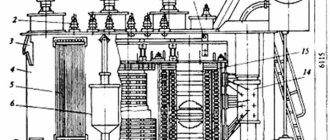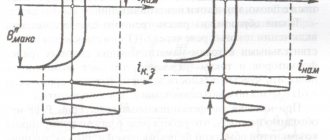Metal parts in a car or various electrical devices have the ability to move in a magnetic field and intersect with power lines. Thanks to this, self-induction is formed. We propose to consider anomalous Foucault eddy currents, air flows, their definition, application, influence and how to reduce eddy current losses in a transformer.
Faraday's law states that a change in magnetic flux produces an induced electric field even in empty space.
If a metal plate is inserted into this space, the induced electric field causes an electric current to flow through the metal. These induced currents are called eddy currents.
Photo: Eddy currents
Foucault currents are flows, the induction of which is carried out in the conductive parts of various electrical devices and machines; stray Foucault currents are especially dangerous for the passage of water or gases, because. their direction cannot be controlled in principle.
If induced counter currents are created by a changing magnetic field, then the eddy currents will be perpendicular to the magnetic field, and their movement will be in a circle if the field is uniform. These induced electric fields are very different from the electrostatic electric fields of point charges.
Discovery of eddy currents
Eddy electric currents were discovered by the French scientist Arago D.F. The scientist experimented with a copper disk and a needle that was magnetized.
It spun around the disk, at some point in time it began to repeat the movements of the arrow. Scientists of that time did not find an explanation for the phenomenon - this strange movement was called the “Arago phenomenon.” The mystery was waiting for its time.
A few years later, Maxwell Faraday, who at that time discovered his famous law of electromagnetic induction, became interested in the question.
According to the law, M. Faraday put forward the assumption that a moving magnetic field has an effect on the atomic metal lattice of a copper conductor.
Electric current resulting from the directed movement of electrons always creates a magnetic field along the entire perimeter of the conductor. The experimental physicist Foucault described eddy currents in detail, based on the works of Arago and Faraday, from which they received their second name.
What is the nature of eddy currents?
Closed cyclic currents can occur in conductors in cases where the magnetic field around these conductors is not stable, that is, constantly changing over time or dynamically rotating.
Thus, the strength of the eddy current directly depends on the rate of change of the magnetic flux piercing the conductor. It is known that electrons in a conductor move linearly due to potential differences, so the electric current is directed directly.
Foucault currents manifest themselves differently and close directly in the body of the conductor, forming vortex-like cyclic circuits. They are able to interact with the magnetic field, as a result of which they arose. (Figure 1)
Eddy currents in a conductor
In the figure we can clearly see how the currents of interest to us increase with increasing induction level (shown by dotted guides) in the middle of the coil, which is connected to alternating current.
Studying Foucault's eddy currents, the Russian scientist Lenz concluded that the own magnetic field of these currents does not allow the magnetic flux, of which they are the cause, to change. The nature of the direction of the lines of force of the eddy electric current coincides with the direction vector of the induction current.
Meaning and Application
At the moment the body moves in the created magnetic fields, Foucault currents cause the body to physically slow down in these fields. This ability has long been implemented in the design of a household electric meter. The bottom line is that an aluminum disk rotating under the influence of a magnet slows down. (fig2)
The figure depicts the disk of an electric energy meter, where the solid arrow indicates the direction of rotation of the disk itself, and the dotted arrows indicate the vortex flows
These same interactions helped to realize the idea of creating a pump for pumping molten metals. Foucault currents provoke the appearance of a skin effect. As a result of their action, the conductor efficiency decreases, since in the middle of the conductor cross-section the current is actually absent, but prevails at its periphery.
To reduce electricity losses, especially when transmitting over long distances, a multi-channel cable is used, each core in which has its own insulation. Eddy currents, namely induction furnaces designed on their basis, have found wide application in metallurgy.
I use them for melting metals, pumping them and hardening the surface. And also the properties of eddy currents are used to slow down and stop the metal disc in induction brakes. In modern computing devices and apparatuses, Foucault currents help slow down moving particles.
Relationship between stray current and corrosion on metal
Due to the presence of water and dissolved salts in the ground, any metal structure in the soil is susceptible to corrosion. But if the metal is also exposed to stray currents, then the process becomes electrolytic in nature. According to Faraday's law, the rate of an electrochemical reaction directly depends on the current flowing between the anode and cathode. Consequently, the rate of corrosion of a metal pipe (laid in the ground) will be influenced by the electrical resistance of the soil, as well as the complex nature of the processes occurring in the cathode and anodic zone.
As a result, the metal structure, in addition to normal corrosion, is exposed to leakage currents. This can cause the formation of a galvanic couple, which will significantly accelerate the corrosion process. In practice, there have been cases when a section of a water supply system pipeline that was subject to galvanic corrosion failed after two years, with an estimated service life of 20 years. An example of such an impact is presented below.
Pipe after exposure to stray currents
Discovery of eddy currents
According to historical data, this phenomenon was first discovered at the beginning of the 19th century by the French researcher D. Arago. Specialists know his clear experience. Rotation of the magnetized pointer sets in motion a thin copper disk located a short distance above. The nature of the phenomenon was revealed by M. Faraday, who explained the presented simple example of movement by the interaction of the field and the currents formed in the conductor. They received a specific name after the name of the scientist. Foucault discovered the heating of bodies with a sufficiently strong energy potential of an alternating current source.
Eddy current principles
For a detailed study of the processes, you can consider the effect of fields when connecting a typical induction coil to a source. Alternating current in a conductor forms field lines. Tension creates a potential difference in adjacent loops. The movement of electrons forms eddy currents. They move along trajectories of least resistance, which changes if the products contain impurities, cracks, cavities and other defects.
Ohm's law
Eddy currents are the directed movement of electrons in a conductor. Therefore, the phenomena under consideration can well be described by basic physical formulas and definitions.
The current strength is calculated according to Ohm's law:
I = (-1/R) * (dФ/dt), where:
- R – electrical resistance;
- Ф – magnetic flux;
- dt – time interval.
It is clear that for practical calculations the most difficult thing is to find out the value of conductivity. In addition to the above-mentioned unevenness in the path of current flow (differences in the conductor), the trajectory changes under the influence of an alternating field.
Inductance
It is necessary to emphasize the permeability of the conductor by the electromagnetic field lines. Such an effect, with an increase in the power source current, intensifies the vortex effects in the control sample installed at a short distance. The amplitude of the induced currents and the phase are determined by the load and conductivity of the induction coil. As in the previous example, breaks and other defects in the conductive section have a significant impact on the electrical performance of the structure.
Magnetic fields
The dependence on the material parameters is shown in the figure. The numbers indicate:
- steam or diamagnetic materials;
- ferrites;
- iron.
How currents will arise in different samples under equal general conditions
Flaw detection
The considered disadvantages can be converted into advantages. Changes in eddy currents determine the presence of defects when scanning control samples. When creating measuring instruments, the following factors are taken into account:
- conductivity determines the strength and path of currents;
- Smooth surfaces are easier to explore;
- vortex processes are activated when the working area decreases.
Detecting a contour with a flaw detector
Taking into account the intended purpose, the design and placement of the sensors are adjusted. As a rule, the coil is installed closer to the measurement location. The shape of the product is adjusted to better suit the object being examined.
Reduction of eddy currents
To successfully combat the negative manifestations of vortex effects in the electric power industry and other areas, they use the noted features. In particular, the resistance of conductors is increased by adding silicon and other additives. Sets of plates are placed parallel to the magnetic flux vector. Provide reliable insulation of structural elements.
Discovery of eddy currents
According to historical data, this phenomenon was first discovered at the beginning of the 19th century by the French researcher D. Arago. Specialists know his clear experience. Rotation of the magnetized pointer sets in motion a thin copper disk located a short distance above. The nature of the phenomenon was revealed by M. Faraday, who explained the presented simple example of movement by the interaction of the field and the currents formed in the conductor. They received a specific name after the name of the scientist. Foucault discovered the heating of bodies with a sufficiently strong energy potential of an alternating current source.
Discovery of eddy currents
According to historical data, this phenomenon was first discovered at the beginning of the 19th century by the French researcher D. Arago. Specialists know his clear experience. Rotation of the magnetized pointer sets in motion a thin copper disk located a short distance above. The nature of the phenomenon was revealed by M. Faraday, who explained the presented simple example of movement by the interaction of the field and the currents formed in the conductor. They received a specific name after the name of the scientist. Foucault discovered the heating of bodies with a sufficiently strong energy potential of an alternating current source.
Foucault's currents in human economic activity
The simplest example of the manifestation of Foucault currents in everyday life is their effect on the magnetic circuit of a winding transformer. Due to the influence of induced currents, low-frequency vibration appears (the transformer hums), which contributes to strong heating. In this case, energy is wasted and the efficiency of the installation decreases. To prevent significant losses, transformer cores are not made in one piece, but are assembled from thin strips of electrical steel with low electrical conductivity. The strips are insulated between each other with electrical varnish or a layer of scale. The advent of ferrite elements made it possible to manufacture small-sized magnetic cores in one piece. The effect of eddy currents is used throughout industry and mechanical engineering. Magnetic levitation trains use Foucault currents for braking, and high-precision instruments have a pointer damping system based on the action of eddy currents. Induction furnaces are widely used in metallurgy, having a whole range of advantages over similar installations. In an induction furnace, the heated metal can be placed in an airless space, ensuring its complete degassing. Induction melting of ferrous metals has also become widespread in metallurgy due to the high efficiency of installations.
Measurement methods
In order to determine the places where stray currents are most likely to form, measurements must be taken. The information obtained about stray direct currents makes it possible to more effectively construct protective measures. Measurements are a system of measures that includes the following elements:
- Determination of resistance between the soil and the rails of electric transport.
- Calculation of the potential difference between the rails along which electric vehicles move and underground pipelines.
- A detailed study of possible power leaks from the cable along its entire length.
When taking measurements on electric transport routes, you need to choose the time of greatest activity. The devices used must have an accuracy class of at least 1.5.
When laying underground pipelines, measurements of stray currents are carried out every 1000 m. If similar structures are located in parallel, then measurements are performed with an interval of 200 m. In this case, the indicators are compared along each pipeline. Additionally, the potential difference between them is measured.
What corrosion looks like on a heated towel rail Source aquanerzh.ru
Possible problems
Vortex species conduct energy and dissipate it, releasing Joule heat. This energy from the rotor of an asynchronous propulsion system is prepared from furromagnets and contributes to heating of the cores.
To combat this phenomenon, the cores are made of thin steel, covered with insulation and installed across the plates. If the plates are thin, they have low bulk density. Thanks to ferrites and substances with high magnetoresistance, the cores are made solid. Directing them weakens the energy inside the wire.
As a result, it is uneven. This is the phenomenon of skin effect or surface effect due to which the inner conductor is useless and conductor tubes are used in circuits where there is high frequency.
Note! The skin effect is used to heat the surface metal for metal hardening. In this case, hardening can be carried out at any depth
Problems caused by induced currents
Foucault currents are inductive currents that arise in large solid conductors. Denoted by the letter f. They have the property of heating conductors. As a result, they are more often used in induction-type ovens
It is important to note that they are capable of generating a magnetic field. This is the mechanism of their work
In some cases they are useful, in others they are undesirable. In any case, they are used in many devices.
How to reduce losses
Energy losses in the magnetic circuit are not beneficial, so how to deal with them? To reduce their size, the core is made from thin plates of electrical steel - these are unique preventive measures to reduce parasitic currents. Such losses are described by a formula that can be used to calculate:
As you know: the smaller the cross-section of the conductor, the greater its resistance, and the greater its resistance, the less the current. The plates are isolated from each other with scale or a layer of varnish. The cores of large transformers are tightened with an insulated pin. This reduces core losses, i.e. These are the main ways to reduce Foucault currents.
What are the consequences of this phenomenon? The magnetic field that arises due to the flow of Foucault currents weakens the field that caused them to arise. That is, eddy currents reduce the strength of electromagnets. The same applies to the design of parts of electric motors and generators: rotor and stator.
Meaning
The faster a conducting body moves in a field, the stronger the Foucault currents will be. The frequency of alternating current and its amplitude, when increasing, also contribute to their increase. When a conducting body is exposed to an electromagnet with alternating current, eddy currents increase with increasing frequency of the current and its amplitude. The direction of rotation of the “vortex” is determined by a similar magnetic flux parameter. If the latter increases, that is, the rate of change is positive (dФ / dt > 0), the eddy currents rotate clockwise.
When the magnetic flux decreases (dФ / dt < 0), the direction of rotation changes to the opposite. The “vortex” of charges in the body chooses such a plane of rotation to provide maximum resistance to the force that causes them (Lenz’s rule). This plane makes a right angle with the lines of force of the inducing field.
In this case, the eddy currents themselves generate a magnetic field directed against the external (inducing) magnetic field that causes them. This is the mechanism of interaction of Foucault currents with an inductor, which caused the disk to rotate in Arago’s experiment.
Options for reducing the strength of vortex flows
To increase the efficiency of various technical devices, a significant reduction in eddy currents is required. This requires an increase in the electrical resistance of the magnetic circuit. The method of reducing the harmful effects of Foucault currents depends directly on the type of electrical equipment.
During the assembly process, the armature cores of machines with direct current and the magnetic wires of devices with alternating current are carefully insulated from each other using special plates made of stamped sheet electrical steel, the thickness of which can vary from 0.1 to 0.5 mm, and “baked” special varnishes or scale. The plates must be located parallel to the magnetic fluxes.
What are eddy currents?
Electricity surrounds us not only in production, but also in everyday life. A person may not even know what eddy currents are, but he encounters the work they do every day. For example, people have long been accustomed to turning on the light by simply pressing the switch key, without thinking about the processes occurring during this process. This is what happened in this case. Therefore, in order to understand what is hidden under the term “Foucault eddy currents” and determine the mechanism of their occurrence, it is necessary to recall the properties of electric current. But first, let’s answer the question “why Foucault”?
Eddy currents were first mentioned in the works of the French physicist D. F. Arago
He noticed the strange behavior of the copper disk, above which was a rotating magnetized arrow. For no apparent reason, the disk began to rotate along with the rotation of the arrow
At that time (1824), they could not yet explain this behavior, so the phenomenon was called the “Arago phenomenon.” A few years later, another scientist, M. Faraday, applying the law of electromagnetic induction discovered by him to the Arago phenomenon, came to the conclusion that in this case the movement of the disk can be easily explained from the point of view of the mentioned law. According to the proposed explanation, a rotating magnetic field acts on the atoms of the conductor (copper disk) and causes the appearance of directed movement of charged (polarized) particles in the structure. One of the properties of electric current is that there is always a magnetic field around the conductor. It is not difficult to guess that eddy currents also create their own field, which interacts with the main one that generates them. The word “eddy” characterizes the way such currents propagate in a conductor: their directions are looped. Based on the work of Arago and Faraday, eddy currents were seriously studied by the physicist Foucault. Hence the name it got.
These currents are not much different from the induction currents generated by generators. If there is a vortex magnetic field (alternating, rotating) and a nearby conductor, then currents are induced in it due to the action of electromagnetic fields. The larger and more massive the conductor, the higher the effective value of the currents created. Moreover, eddy currents always create a magnetic field that resists changes in flow. As the underlying current increases, the counter-directed EMF increases, and when it decreases, on the contrary, the field of eddy currents supports the main flow. The above follows from Lenz's law.
It is impossible to say unequivocally whether eddy currents are useful or harmful: in some cases they are regarded as parasitic and various technological solutions are used to reduce them, while in others, on the contrary, the very properties of such currents are in demand. Every inquisitive boy has once taken apart a discarded transformer. The core (the base on which the winding turns are wound) is always made not as one piece, but is made up of a large number of thin plates of electrical steel (it is called laminated). All plates that make up the structure are coated with insulating varnish and baked for a reliable connection. Sometimes the core is additionally tightened with an insulated pin. This complication of the design is forced: it is necessary to significantly reduce eddy currents in the core. After all, as already mentioned, the less massive the conductor, the greater the resistance to electric current it has.
In other cases, some properties of eddy currents are in demand. For example, the operation of induction steel-smelting furnaces is based on the action of eddy currents induced by a special generator that heats a massive conductor. In addition, they are used to determine the presence of invisible defects in the structure of the metal.
fb.ru>
Application
The thermal effect of Foucault currents is used in induction furnaces, where a conductive body is placed in a coil powered by a high-power high-frequency generator, in which eddy currents arise, heating it to melting. Induction cookers work in a similar way, in which metal cookware is heated by eddy currents created by the alternating magnetic field of a coil located inside the cooker.
With the help of Foucault currents, the metal parts of vacuum installations are heated to degas them.
In accordance with Lenz's rule, eddy currents flow inside a conductor along such paths and directions that their action can resist the cause that causes them as strongly as possible. As a result, when moving in a magnetic field, good conductors are subject to a braking force caused by the interaction of eddy currents with the magnetic field. This effect is used in a number of devices to dampen vibrations of their moving parts.
In many cases, Foucault currents may be undesirable. To combat them, special measures are taken: in order to prevent energy losses due to heating of transformer cores, these cores are assembled from thin plates separated by insulating layers (charging). The advent of ferrites made it possible to manufacture these cores as solid ones.
Eddy current testing is one of the methods of non-destructive testing of products made of conductive materials.
Brief Definition
Eddy currents are currents that flow in conductors under the influence of an alternating magnetic field. The field does not necessarily have to change; a body can move in a magnetic field, but a current will still begin to flow in it.
It is impossible to find the real trajectory of current movement to take them into account; the current flows where it finds the path with the least resistance. Eddy currents always flow in a closed loop. The main conditions for its occurrence are the presence of an object in an alternating magnetic field or its movement relative to the field.
What are eddy currents
Eddy currents are considered one of the most amazing phenomena found in electrical engineering. It is amazing that humanity has learned to use the negative aspects of eddy currents for good.
History of the discovery of eddy currents
In 1824, French physicist Daniel Arago first observed the effect of eddy currents on a copper disk located under a magnetic needle on one axis. When the needle rotated, eddy currents were induced in the disk, causing it to move. This phenomenon is called the "Arago effect" in honor of its discoverer.
Research on eddy currents was continued by the French physicist Jean Foucault. He described in detail their nature and principle of operation, and also observed the phenomenon of heating of a conductive ferromagnet rotated in a static magnetic field. Currents of a new nature were also named after the researcher.
The nature of eddy currents
Foucault currents can occur when a conductor is exposed to an alternating magnetic field, or when a conductor moves in a static magnetic field. The nature of eddy currents is similar to induction currents, which arise in linear wires when an electric current passes through them. The direction of eddy currents is closed in a circle and opposite to the force that causes them.
Foucault's currents in human economic activity
The simplest example of the manifestation of Foucault currents in everyday life is their effect on the magnetic circuit of a winding transformer. Due to the influence of induced currents, low-frequency vibration appears (the transformer hums), which contributes to strong heating. In this case, energy is wasted and the efficiency of the installation decreases. To prevent significant losses, transformer cores are not made in one piece, but are assembled from thin strips of electrical steel with low electrical conductivity. The strips are insulated between each other with electrical varnish or a layer of scale. The advent of ferrite elements made it possible to manufacture small-sized magnetic cores in one piece.
The effect of eddy currents is used throughout industry and mechanical engineering. Magnetic levitation trains use Foucault currents for braking, and high-precision instruments have a pointer damping system based on the action of eddy currents. Induction furnaces are widely used in metallurgy, having a whole range of advantages over similar installations. In an induction furnace, the heated metal can be placed in an airless space, ensuring its complete degassing. Induction melting of ferrous metals has also become widespread in metallurgy due to the high efficiency of installations.
KakProsto.ru>
Which objects are at greatest risk?
It is impossible to completely control the formation of stray currents. To protect against their effects, you must first pay attention to the objects that are most vulnerable to them:
- Cable lines with a metal sheath.
- Pipelines whose walls are made of metal. If the pipes are made of other materials, then stray currents will not affect them. Moreover, we are talking about different types of such structures: water supply, sewer, gas.
- Metal parts of fittings in buildings and other structures.
- Electric transport routes. It can be city or railway electrified.
- Underground electric transport can be used, for example, in the construction of a subway.
- Various types of all-metal structures. One example would be a tank designed to store petroleum products.
In fact, the danger in question can threaten any metal elements in direct contact with the ground. Understanding what “stray currents” are will help you understand how to avoid them.
Law of electromagnetic induction. Vortex electric field. Eddy currents
Details Electric current in a circuit is possible if external forces act on the free charges of the conductor. The work done by these forces to move a single positive charge along a closed loop is called emf. When the magnetic flux changes through the surface limited by the contour, extraneous forces appear in the circuit, the action of which is characterized by the induced emf. Considering the direction of the induction current, according to Lenz's rule:
The induced emf in a closed loop is equal to the rate of change of the magnetic flux through the surface bounded by the loop, taken with the opposite sign.
Why? - because the induced current counteracts the change in the magnetic flux, the induced emf and the rate of change of the magnetic flux have different signs.
If we consider not a single circuit, but a coil, where N is the number of turns in the coil:
The magnitude of the induction current can be calculated using Ohm's law for a closed circuit
where R is the conductor resistance.
VORTEX ELECTRIC FIELD
The reason for the occurrence of electric current in a stationary conductor is the electric field. Any change in the magnetic field generates an inductive electric field, regardless of the presence or absence of a closed circuit, and if the conductor is open, then a potential difference arises at its ends; If the conductor is closed, then an induced current is observed in it.
The inductive electric field is vortex. The direction of the lines of force of the vortex electric field coincides with the direction of the induction current. The induction electric field has completely different properties in contrast to the electrostatic field.
Electrostatic field - created by stationary electric charges, field lines are open - - potential field, the sources of the field are electric charges, the work of field forces to move a test charge along a closed path is 0
Induction electric field (vortex electric field) - caused by changes in the magnetic field, the lines of force are closed (vortex field), field sources cannot be specified, the work of field forces to move a test charge along a closed path is equal to the induced emf.
Eddy currents
Induction currents in massive conductors are called Foucault currents. Foucault currents can reach very large values, because The resistance of massive conductors is low. Therefore, transformer cores are made from insulated plates. In ferrites - magnetic insulators, eddy currents practically do not arise.
Use of eddy currents
— heating and melting of metals in a vacuum, dampers in electrical measuring instruments.
Harmful effects of eddy currents
- These are energy losses in the cores of transformers and generators due to the release of large amounts of heat.
Next page “Induction emf in moving conductors”
Back to section “Grades 10-11”
Electromagnetic field - Cool physics
Interaction of currents. A magnetic field. Magnetic induction vector. Ampere force - The effect of a magnetic field on a moving charge. Magnetic properties of matter - The phenomenon of electromagnetic induction. Magnetic flux. Direction of induction current. Lenz's rule - EMF of electromagnetic induction. Vortex electric field - induced emf in moving conductors - Self-induction. Inductance. Magnetic field energy. Questions for work
Beneficial and harmful effects
Foucault currents have beneficial and harmful effects. They heat and melt metals in the vacuum and damper areas, but at the same time, energy losses occur in the areas of transformer cores and generators due to the large amount of heat generated.
Beneficial effect of induction currents
Notes
- The term vortex
means that the current lines of force are closed. - Induction
is an electric current created (induced) in a conductor due to the interaction of the conductor with a time-varying magnetic (electromagnetic) field, and not due to the action of current sources and EMF (galvanic elements, etc.) included in the circuit break. - currents
is often used in the plural, since Foucault currents represent an electric current in the volume of a conductor, and unlike the induction current in the secondary winding of a transformer, it is difficult to indicate
a single
“electrical circuit” for the current, a single closed path of movement of electric charges in the thickness of the conductor. - Strictly speaking, under the influence of an alternating electromagnetic field
- That is, having a large cross-sectional area
Practical applications of eddy currents
Application and operation of SF6 circuit breakers
The passage of a strong current increases the energy potential of the molecular lattice, which is accompanied by heating. This phenomenon explains the possibility of using appropriate technology to non-contactly increase the temperature of conductive materials. If we give an example with an induction hob, we can highlight the following advantages:
- the formation of heat deep in the bottom of the pan ensures effective heating of the working area;
- the temperature on the panel surface does not increase excessively;
- The thermal effect on products is carried out faster compared to analogues (spiral heating elements, gas stoves).
It is not difficult to give an example based on experience with disk rotation. The same principle is implemented in the design of an electromechanical energy meter. In this case, the rotation of the working unit is ensured by induced currents. Acceleration/deceleration corresponds to the change in power in the load.
By increasing the current, it is possible to heat metals (alloys) to the melting point
When carefully studying thematic issues, you can find certain disadvantages. Electromagnetic flux in a solid transformer core can increase energy losses. For this reason, the corresponding parts are created from a set of plates coated with a layer of dielectric. These elements are connected by an insulated rod.
The reason for the occurrence of Foucault currents (what are their harms or benefits).
Yuri Masalyga
When current passes through a conductor, a magnetic field is created prependicular to the flowing current (gimlet rule). This field gives rise to Foucault currents. With sufficient current strength and conductor thickness, Foucault currents become significant and cause heating of the conductor. Therefore, the wires are made multi-core, and the magnetic cores of transformers are assembled from separate insulated plates - this prevents overheating.
Kirill Gribkov
Eddy currents (Foucault currents) are closed induction currents in massive conductors that arise under the influence of an eddy electric field generated by an alternating magnetic field. Eddy currents lead to losses of electricity due to heating of the conductor in which they originated; To reduce these losses, the magnetic circuits of machines and alternating current devices are made of insulated steel plates.
Sergey x
Eddy currents, Foucault currents, are used for melting and surface hardening of metals, and their force action is used in vibration dampers of moving parts of devices and apparatus, in induction brakes (in which a massive metal disk rotates in the field of electromagnets), etc.
The essence of the phenomenon
Eddy or Foucauldian currents are those that flow due to the influence of an alternating magnetic field. In this case, it is not the field itself that changes, but the conductive position of this field. That is, if a conductive movement of a static field occurs, then energy will still be generated in it.
Toki Fuko
Foucaults arise where an alternating magnetic field changes and in fact they are no different from energy flowing through wires or secondary electrical transformer windings.
Definition from the textbook
Application in practice
Now about the useful areas of application of Foucault currents. A huge contribution was made to metallurgy with the invention of induction steelmaking furnaces. They are designed in such a way that a molten mass of metal is placed inside a coil through which a high-frequency current flows. Its magnetic field induces large currents within the metal until it completely melts.
Author's note!
The development of induction furnaces has significantly improved the environmental friendliness of metal production and changed the understanding of smelting methods. I work at a metallurgical plant, where ten years ago they launched a new high-tech workshop with such installations, and a few years after the development of the new equipment, the classic open-hearth furnace was closed. This indicates the productivity of this method of heating metals. Eddy currents are also used to surface harden metal.
Visual application in practice:
In addition to metallurgy, they are used in the production of electric vacuum devices. The problem is the complete removal of gases before sealing the flask. Using Foucault currents, the electrodes of the lamp are heated to high temperatures, thus deactivating the gas.
In everyday life, you can come across kitchen induction stoves on which food is prepared, thanks to the use of this phenomenon. As you can see, eddy currents have their pros and cons.
Foucault's currents are both beneficial and harmful. In some cases, their influence entails non-electrical problems. For example, a pipeline laid near cable lines rots faster without any apparent third-party reasons. At the same time, induction heating devices have shown themselves to be quite good, especially since you can assemble such a device for household use yourself. We hope you now know what Foucault eddy currents are, as well as what applications they have found in production and in everyday life.
Methods of protection
Various methods can be used for protection. They are divided into two main types: passive and active. In the first case, we are talking about reliable insulation of pipes from the surrounding soil. To do this, you can use several layers of protection.
Ground urban electric transport Source amperof.ru
When it is necessary to exclude stray currents in water pipes, bitumen mastics, special casings, and insulating tapes can be used. Work must be carried out with caution, since mechanical damage to the protective layer can become places where active destruction of the object occurs.
An effective way of protection is to replace metal pipes with plastic ones. After this, they will no longer be a place where current flows. As a result, electrolytic processes that destroy the structure will stop.
To isolate the rails from the ground, special protection is laid. As a result, the paths are positioned higher than usual. Typically, embankments made of non-electrically conductive material are used for this purpose. This leads to increased costs and is not always acceptable for electric transport, the route of which is located within the city.
When designing pipelines, the location of electrical cables, and electric transport routes, they try, if possible, to spread them over a considerable distance.
What are eddy currents
Eddy currents are considered one of the most amazing phenomena found in electrical engineering. It is amazing that humanity has learned to use the negative aspects of eddy currents for good.
History of the discovery of eddy currents
In 1824, French physicist Daniel Arago first observed the effect of eddy currents on a copper disk located under a magnetic needle on one axis. When the needle rotated, eddy currents were induced in the disk, causing it to move. This phenomenon is called the "Arago effect" in honor of its discoverer.
Research on eddy currents was continued by the French physicist Jean Foucault. He described in detail their nature and principle of operation, and also observed the phenomenon of heating of a conductive ferromagnet rotated in a static magnetic field. Currents of a new nature were also named after the researcher.
The nature of eddy currents
Foucault currents can occur when a conductor is exposed to an alternating magnetic field, or when a conductor moves in a static magnetic field. The nature of eddy currents is similar to induction currents, which arise in linear wires when an electric current passes through them. The direction of eddy currents is closed in a circle and opposite to the force that causes them.
Foucault's currents in human economic activity
The simplest example of the manifestation of Foucault currents in everyday life is their effect on the magnetic circuit of a winding transformer. Due to the influence of induced currents, low-frequency vibration appears (the transformer hums), which contributes to strong heating. In this case, energy is wasted and the efficiency of the installation decreases. To prevent significant losses, transformer cores are not made in one piece, but are assembled from thin strips of electrical steel with low electrical conductivity. The strips are insulated between each other with electrical varnish or a layer of scale. The advent of ferrite elements made it possible to manufacture small-sized magnetic cores in one piece.
The effect of eddy currents is used throughout industry and mechanical engineering. Magnetic levitation trains use Foucault currents for braking, and high-precision instruments have a pointer damping system based on the action of eddy currents. Induction furnaces are widely used in metallurgy, having a whole range of advantages over similar installations. In an induction furnace, the heated metal can be placed in an airless space, ensuring its complete degassing. Induction melting of ferrous metals has also become widespread in metallurgy due to the high efficiency of installations.
KakProsto.ru>
No tags for this post.
